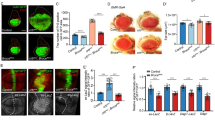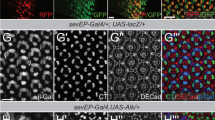Abstract
Adenomatous polyposis coli protein (APC) is an important tumour suppressor in the human colon epithelium. In a complex with glycogen synthase kinase-3 (GSK-3), APC binds to and destabilizes cytoplasmic (‘free’) β-catenin. Here, using a yeast two-hybrid screen for proteins that bind to the Drosophila β-catenin homologue, Armadillo, we identify a new Drosophila APC homologue, E-APC. E-APC also binds to Shaggy, the Drosophila GSK-3 homologue. Interference with E-APC function produces embryonic phenotypes like those of shaggy mutants. Interestingly, E-APC is concentrated in apicolateral adhesive zones of epithelial cells, along with Armadillo and E-cadherin, which are both integral components of the adherens junctions in these zones. Various mutant conditions that cause dissociation of E-APC from these zones also obliterate the segmental modulation of free Armadillo levels that is normally induced by Wingless signalling. We propose that the Armadillo-destabilizing protein complex, consisting of E-APC, Shaggy, and a third protein, Axin, is anchored in adhesive zones, and that Wingless signalling may inhibit the activity of this complex by causing dissociation of E-APC from these zones.
This is a preview of subscription content, access via your institution
Access options
Subscribe to this journal
Receive 12 print issues and online access
$209.00 per year
only $17.42 per issue
Buy this article
- Purchase on Springer Link
- Instant access to full article PDF
Prices may be subject to local taxes which are calculated during checkout







Similar content being viewed by others
References
Kinzler, K. W. & Vogelstein, B. Lessons from hereditary colorectal cancer. Cell 87, 159–170 (1996).
Polakis, P. The adenomatous polyposis coli (APC) tumor suppressor. Biochim. Biophys. Acta 1332, F127–F147 (1997).
Perrimon, N. The genetic basis for patterned baldness in Drosophila. Cell 76, 781–784 (1996).
Miller, J. R. & Moon, R. T. Signal transduction through β-catenin and specification of cell fate during embryogenesis. Genes Dev. 10, 2527–2539 (1996).
Munemitsu, S., Albert, I., Souza, B., Rubinfeld, B. & Polakis, P. Regulation of intracellular β-catenin levels by the adenomatous polyposis coli (APC) tumour-suppressor protein. Proc. Natl Acad. Sci. USA 92, 3046–3050 (1995).
Nusse, R. A versatile transcriptional effector of Wingless signaling. Cell 89, 321–323 (1997).
Korinek, V. et al. Constitutive transcriptional activation by a β-catenin-Tcf complex in APC–/– colon carcinoma. Science 275, 1784–1787 (1997).
Morin, P. J. et al. Activation of β-catenin-Tcf signaling in colon cancer by mutations in β-catenin or APC. Science 275, 1787–1790 (1997).
He, T.-C. et al. Identification of c-MYC as a target of the APC pathway. Science 281, 1509–1512 (1998).
Tetsu, O. & McCormick, F. β-catenin regulates expression of cyclin D1 in colon carcinoma cells. Nature 398, 422–426 (1999).
Vleminckx, K. et al. Adenomatous polyposis tumor suppressor protein has signaling activity in Xenopus embryos resulting in the induction of an ectopic dorsoanterior axis. J. Cell Biol. 136, 411–420 (1997).
Rocheleau, C. E. et al. Wnt signaling and an APC-related gene specify endoderm in early C. elegans embryos. Cell 90, 707–716 (1997).
Hayashi, S. et al. A Drosophila homolog of the tumor suppressor gene adenomatous polyposis coli down-regulates β-catenin but its zygotic expression is not essential for the regulation of Armadillo. Proc. Natl Acad. Sci. USA 94, 242–247 (1997).
Ahmed, Y., Hayashi, S., Levine, A. & Wieschaus, E. Regulation of Armadillo by a Drosophila APC inhibits neuronal apoptosis during retinal development. Cell 93, 1171–1182 (1998).
Rubinfeld, B. et al. Binding of GSK3-β to the APC-β-catenin complex and regulation of complex assembly. Science 272, 1023–1025 (1996).
Ben-Ze’ev, A. . & Geiger, B. Differential molecular interactions of β-catenin and plakoglobin in adhesion, signaling and cancer. Curr. Opin. Cell Biol. 10, 629–639 (1998).
Yu, X. & Bienz, M. Ubiquitous expression of a Drosophila Adenomatous polyposis coli homolog and its localisation in cortical actin caps. Mech. Dev. (in the press).
Tepass, U. Epithelial differentiation in Drosophila. Bioessays 19, 673–682 (1997).
Riese, J. et al. LEF-1, a nuclear factor coordinating signaling inputs from wingless and decapentaplegic. Cell 88, 777–787 (1997).
Huber, A. H., Nelson, W. J. & Weis, W. I. The three-dimensional structure of the Armadillo repeat region of β-catenin. Cell 90, 871–872 (1997).
Behrens, J. et al. Functional interaction of an axin homolog, conductin, with β-catenin, APC and GSK3β. Science 280, 596–599 (1998).
Foe, V. E., Odell, G. M. & Edgar, B. A. in The Development of Drosophila (eds Bate, M. & Martinez-Arias, A.) 149–300 (Cold Spring Harb. Lab. Press, Cold Spring Harbor, 1993).
Tepass, U. Crumbs, a component of the apical membrane, is required for zonula adherens formation in primary epithelia of Drosophila. Dev. Biol. 177, 217–225 (1996).
Peifer, M., Orsulic, S., Sweeton, D. & Wieschaus, E. A role for the Drosophila segment polarity gene armadillo in cell adhesion and cytoskeletal integrity during oogenesis. Development 118, 681–691 (1993).
Müller, H. A . & Wieschaus, E. armadillo, bazooka and stardust are critical for early stages in formation of the zonula adherens and maintenance of the polarised blastoderm epithelium in Drosophila. J. Cell. Biol. 134, 149–163 (1996).
Cox, R. T., Kirkpatrick, C. & Peifer, M. Armadillo is required for adherens junction assembly, cell polarity, and morphogenesis during Drosophila embryogenesis. J. Cell Biol. 134, 133–148 (1996).
Tepass, U. et al. shotgun encodes Drosophila E-cadherin and is preferentially required during cell rearrangement in the neuroectoderm and other morphogenetically active epithelia. Genes Dev. 10, 672–685 (1996).
Peifer, M., Sweeton, D., Casey, M. & Wieschaus, E. wingless signal and Zeste-white 3 kinase trigger opposing changes in the intracellular distribution of Armadillo. Development 120, 369–380 (1994).
Uemura, T., Oda, H., Kraut, R., Hayashi, S. & Takeichi, M. Processes of dynamic epithelial cell rearrangement are the major targets of cadE/shotgun mutations in the Drosophila embryo. Genes Dev. 10, 659–671 (1996).
Knust, E. Control of epithelial polarity in Drosophila. Trends Genet. 10, 275–280 (1994).
Grawe, F., Wodarz, A., Lee, B., Knust, E. & Skaer, H. The Drosophila genes crumbs and stardust are involved in the biogenesis of adherens junctions. Development 122, 951–959 (1996).
Kennerdell, J. R. & Carthew, R. W. Use of dsRNA-mediated genetic interference demonstrate that frizzled and frizzled 2 act in the Wingless pathway. Cell 95, 1017–1026 (1998).
Thüringer, F., Cohen, S. M. & Bienz, M. Dissection of an indirect autoregulatory response of a homeotic Drosophila gene. EMBO J. 12, 2419–2430 (1993).
Yu, X., Hoppler, S., Eresh, S. & Bienz, M. decapentaplegic, a target gene of the wingless signalling pathway in the Drosophila midgut. Development 122, 849–858 (1996).
Waltzer, L. & Bienz, M. Drosophila CBP represses the transcription factor TCF to antagonize Wingless signalling. Nature 395, 521–525 (1998).
Pai, L. M., Orsulic, S., Bejsovec, A. & Peifer, M. Negative regulation of Armadillo, a Wingless effector in Drosophila. Development 124, 2255–2266 (1997).
Miyashiro, I. et al. Subcellular localization of the APC protein: immunoelectron microscopic study of the association of the APC protein with catenin. Oncogene 11, 89–96 (1995).
Näthke, I. S., Adams, C. L., Polakis, P., Sellin, J. H. & Nelson, W. J. The adenomatous polyposis coli tumor suppressor protein localizes to plasma membrane sites involved in active cell migration. J. Cell Biol. 134, 165–179 (1996).
Neufeld, K. L. & White, R. L. Nuclear and cytoplasmic localizations of the adenomatous polyposis coli protein. Proc. Natl Acad. Sci. USA 94, 3034–3039 (1997).
Hülsken, J., Behrens, J. & Birchmeier, W. Tumor-suppressor gene products in cell contacts: the Cadherin-APC-armadillo connection. Curr. Opin. Cell Biol. 6, 711–716 (1994).
Fagotto, F., Guger, K. & Gumbiner, B. M. Binding to cadherin antagonizes the signaling activity of β-catenin during axis formation in Xenopus. J. Cell Biol. 132, 1105–1114 (1996).
Sanson, B., White, P. & Vincent, J.-P. Uncoupling cadherin-based adhesion from wingless signalling in Drosophila. Nature 383, 627–630 (1996).
Orsulic, S. & Peifer, M. An in vivo structure-function study of Armadillo, the β-catenin homologue, reveals both separate and overlapping regions of the protein required for cell adhesion and for Wingless signalling. J. Cell Biol. 134, 1283–1300 (1996).
Hamada, F. et al. Negative regulation of Wingless signaling by D-Axin, a Drosophila homolog of Axin. Science 283, 1739–1742 (1999).
Rubinfeld, B., Robbins, P., El-Gamil, M., Albert, I., Porfiri, E. & Polakis, P. Stabilization of β-catenin by genetic defects in melanoma cell lines. Science 275, 1790–1792 (1997).
Fehon, R. G., Johansen, K., Rebay, I. & Artavanis-Tsakonas, S. Complex cellular and subcellular regulation of Notch expression during embryonic and imaginal development of Drosophila: implications for Notch function. J. Cell Biol. 113, 657–659 (1991).
Simske, J. S., Kaech, S. M., Harp, S. A. & Kim, S. K. LET-23 receptor localization by the cell junction protein LIN-7 during C. elegans vulval induction. Cell 85, 195–204 (1996).
Paroush, Z. et al. Groucho is required for Drosophila neurogenesis, segmentation and sex determination and interacts directly with hairy-related bHLH proteins. Cell 79, 805–815 (1994).
Brown, N. & Kafatos, F. Functional cDNA libraries from Drosophila embryos. J. Mol. Biol. 203, 425–437 (1988).
Bourouis, M. et al. An early embryonic product of the gene shaggy encodes a serine/threonine protein kinase related to the CDC28/cdc2+ subfamily. EMBO J. 9, 2877–2884 (1990).
Brand, A. H. & Perrimon, N. Targeted gene expression as a means of altering cell fates and generating dominant phenotypes. Development 118, 401–415 (1993).
Oda, H., Uemura, T., Harada, Y., Iwai, Y. & Tacheichi, M. A Drosophila homolog of cadherin associated with Armadillo and essential for embryonic cell-cell adhesion. Dev. Biol. 165, 716–726 (1994).
Nakagawa, H. et al. Identification of a brain-specific APC homologue, APCL, and its interaction with β-catenin. Cancer Res. 58, 5176–5181 (1998).
van Es, J. H. et al. Identification of APC2, a homologue of the adenomatous polyposis tumour suppressor. Curr. Biol. 9, 105–108 (1999).
Bhanot, P. et al. A new member of the frizzled family from Drosophila functions as a Wingless receptor. Nature 382 225–230,1996).
Acknowledgements
We thank M. Bourouis for the sgg cDNA; A. González-Reyes, H. Skaer, J.-P. Vincent, A. Müller and the Developmental Studies Hybridoma Bank for antibodies and fly strains; B. Amos for help with the confocal microscopy; and M. Freeman and H. Pelham for comments on the manuscript. X.Y. was supported by a studentship from Trinity College, Cambridge.
Correspondence and requests for materials should be addressed to M.B.
Author information
Authors and Affiliations
Corresponding author
Rights and permissions
About this article
Cite this article
Yu, X., Waltzer, L. & Bienz, M. A new Drosophila APC homologue associated with adhesive zones of epithelial cells. Nat Cell Biol 1, 144–151 (1999). https://doi.org/10.1038/11064
Received:
Revised:
Accepted:
Published:
Issue Date:
DOI: https://doi.org/10.1038/11064
This article is cited by
-
Spindle orientation, asymmetric division and tumour suppression in Drosophila stem cells
Nature Reviews Genetics (2007)
-
Flying at the head of the pack: Wnt biology in Drosophila
Oncogene (2006)
-
A Drosophila APC tumour suppressor homologue functions in cellular adhesion
Nature Cell Biology (2002)
-
The subcellular destinations of apc proteins
Nature Reviews Molecular Cell Biology (2002)



